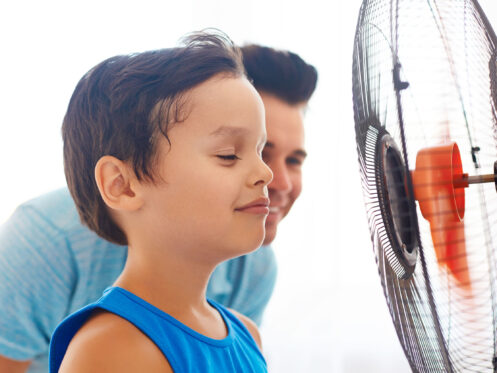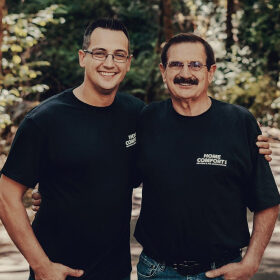Air conditioning is no longer just a comfort, but is a survival tool during a long, hot summer. If you’re trying to decide how to keep your space cool without wasting money or energy, you’re probably stuck between two very different options: portable units and central air systems. They each have strengths but come with trade-offs that affect your comfort, noise level, and long-term costs. Home Comfort Inc. in Salem, OR, helps homeowners sort through these choices so you can cool your home with confidence.
Cooling One Room vs. Cooling the Whole House
Think about how you use your home during the hottest months. You might only hang out in one room during the day, may move from space to space, or want the whole house to be at the same temperature. That difference matters when choosing between a portable unit and a central AC system. A portable unit cools one room. It sits on the floor, plugs into a regular outlet, and pushes hot air out a window with a flexible exhaust hose. That setup works fine if you’re cooling a single bedroom or office, but the cold air stays trapped in that space.
Central air, on the other hand, moves cooled air through a network of ducts. It doesn’t matter which room you’re in. You get even temperatures across the entire house. That’s useful if you have family members on opposite sides of the home or don’t want to wait for a portable unit to catch up after the sun moves across the roof. A portable unit might make more sense if you spend most of your day in one part of the house. But if you want consistent comfort everywhere, a central AC gives you that reach without juggling machines.
What the Noise Tells You
With a portable AC, the motor sits right there in the room. Every time the compressor turns on, you hear it. Some units hum quietly, but others sound like a box fan paired with a vacuum. That noise adds up if you’re a light sleeper or work from home. You’ll probably turn it off during phone calls or adjust the settings at night to keep the volume down. Even when the unit works well, the sound becomes part of the background.
Central AC systems place the noisiest parts outside. You hear a soft whoosh from the vents, but the rest of the operation happens beyond the walls. That quiet feel makes a big difference during long heat spells when the system runs for hours. If you want a space that stays calm and cool without drawing attention to itself, central air wins the noise battle easily. You don’t have to trade peace for temperature.
Installation Process and What It Takes to Get Started
Portable air conditioners don’t need much work to get them going. You unbox them, wheel them into place, and plug them in. Most units come with a kit that fits a vertical or horizontal window, so the warm air has somewhere to go. The setup takes less than half an hour. You can move the unit to another room, if needed. That flexibility works well in apartments or homes where you can’t modify the structure.
Central AC takes more commitment. You need an outdoor compressor, an indoor evaporator coil, and a working duct system. If your home already has forced-air heat, the ductwork might be ready. If not, installing ducts means opening walls and planning routes through ceilings or crawl spaces. The upfront work takes longer, but you don’t have to think about it again once it’s done. The system is behind the scenes, and you control everything from a single thermostat. If you plan to stay in your home long term, that fixed system might be worth the investment, especially if the ductwork improves your heating.
Power Use and Monthly Energy Bills
Portable units work hard to cool one area but draw a surprising amount of electricity. They run continuously to keep the room at a set temperature. They create negative pressure by pulling air inside the room to cool the condenser and vent it outside. That means warm air from other parts of the house sneaks in under the door or through cracks. The unit fights that flow constantly, using more power than expected for something so small.
Central AC systems use more energy at once but move it more efficiently. They cool the air, circulate it through ducts, and cycle off when the thermostat hits the set point. In well-insulated homes, cycling helps manage power use. Some systems use variable-speed compressors that ramp up and down based on demand, which smooths out peaks and lowers bills. If your portable unit runs day and night during a heat wave, you might not save as much as you hoped. Central systems offer better cost control once you factor in usage habits and overall coverage.
Maintenance and Long-Term Upkeep
Portable air conditioners need frequent attention. You have to empty the water reservoir or connect a drain hose, especially in humid climates. Dust can clog filters quickly. Some units have washable filters, but others need replacements every few months. The exhaust hose can crack or shift, letting hot air leak into the room. If you don’t check it regularly, performance drops fast.
Central air conditioners require scheduled tune-ups. You should have a technician clean the coils, check refrigerant levels, and test the system before summer hits. Filter replacement still matters, but it’s usually one or two standard filters for the entire system, not one for every room. The repair might cost more than replacing a small portable unit if something fails, like a capacitor or fan motor. When it works, it fades into the background.
Contact Home Comfort Inc. today!
Space and Aesthetic Trade-Offs
Portable units take up floor space. Even the compact ones need a clear path to a window, which limits how you arrange furniture. The hose sticks out, and the unit becomes part of the room’s layout. That machine might always feel in the way if you value clean lines or open floor plans. You also have to find a place to store it during the winter, especially if you don’t use it year-round.
Central air systems live behind walls and ceilings. They don’t take up any usable space inside the home. You get cooling without seeing the equipment. The vents can be subtle or styled to match the room. Once the installation’s done, you don’t have to rearrange furniture or make room for the system.
When Temporary Cooling is the Priority
Sometimes you only need cooling for a short season or in a space that doesn’t justify a full system. Maybe it’s a detached garage, a sunroom, or a guest room that only gets used on occasion. In those cases, portable units work well enough to bridge the gap. You get relief without major changes, and you can move the unit out when it’s not needed.
Choose The Best AC Type For Your Home
The right air conditioning system doesn’t just cool the space, but should add value to your home. If you’re ready to make a smarter cooling choice, consult with Home Comfort Inc. today. We also offer ductless mini-split installations, heat pump services, and indoor air quality upgrades to help you stay comfortable no matter how you cool your home.

